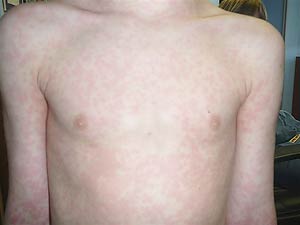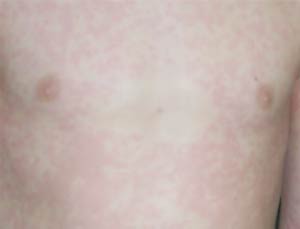A 6-year-old boy who spent time in rural Germany
This previously fit and well 6-year-old boy returned from having spent the summer holidays in rural Germany where he was bitten by a tick about 18 days ago.
The mother removed the tick and they returned to South Africa where I saw him eight days ago.
Although he was asymptomatic apart from the visible bite mark (no classic bull’s eye lesion), I opted to start him on oral amoxicillin. This was decided after his mother did not feel comfortable with “wait and watch” approach. She has heard of cases of facial palsy secondary to Lyme disease and I could not guarantee her that her son would not develop Lyme disease.
Three days after starting amoxil treatment he and his elder sister presented with a viral upper respiratory chest infection and today (day eight of treatment) his mother brought him in again because of a skin rash. He still remains well without any arthritis or neurological symptoms and the rash is non-pruritic.
On examination he had a diffuse maculopapular rash with normal skin around the initial bite mark. He remained afebrile with only evidence of a presumable upper respiratory tract infection. Normal mucosa, no lymphadenopathy or hepatosplenomegaly.
I ordered serology and PCR on blood for Lyme disease as well as serology for EBV.

Questions (as we rarely see Lyme disease in South Africa):
- Should I entertain the diagnosis of a maculopapular rash secondary to amoxicillin usage in possible Epstein-Barr virus infection occurring simultaneously with this central “sparing of the skin” (a variant of a bull’s eye skin lesion) due to presumable Lyme disease?
- Should one stop amoxil and change to IV/I/M/ ceftriaxone (the patient is not known to have a penicillin allergy)?
Answer

Eugene Shapiro, MD, agreed to answer this question from one of our regular readers. He is with Yale University School of Medicine.
Certainly the erythematous rash is consistent with either an amoxicillin-associated rash or a viral exanthem, so it would be reasonable to discontinue treatment with amoxicillin.
Indeed, there is no evidence that prophylactic treatment with amoxicillin is effective in preventing Lyme disease and, in any case, beginning prophylactic treatment nearly three weeks after a tick bite does not make much sense (erythema migrans typically occurs seven to 14 days after the bite, although it may be begin even later).
To assess whether prophylactic treatment is indicated (a single 200 mg dose of doxycycline given within three days of removal of the tick is the only regimen that has been shown to be effective), information about the risk of Lyme disease from this bite would be useful.


Such information would include the species and stage of the tick that caused the bite, the proportion of such ticks that are infected with B. burgdorferi in that area and approximately how long the tick was attached. (Ixodes ticks usually need to be attached for more than 48 hours before risk of transmission becomes substantial). If a child were to develop Lyme disease, it is highly likely that it would manifest as an erythema migrans rash at the site of the bite which could then easily be treated. The clear around the site of the bite is interesting; however, I do not believe that it is a manifestation of erythema migrans and I certainly would not treat this child for Lyme disease. There is no erythema in that area. Perhaps the clear area represents an area of edema in reaction to the tick saliva which somehow protected that area from the generalized exanthem that likely was due to either the amoxicillin or a concomitant viral infection.
Spot the Rash is a monthly case study featured in Infectious Diseases in Children designed to test your skills in pediatric dermatology issues.
